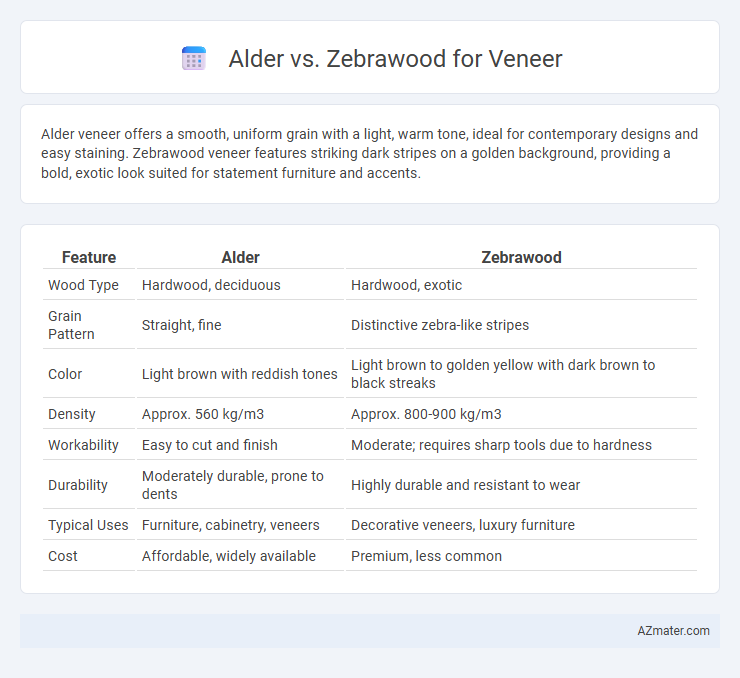Alder veneer offers a smooth, uniform grain with a light, warm tone, ideal for contemporary designs and easy staining. Zebrawood veneer features striking dark stripes on a golden background, providing a bold, exotic look suited for statement furniture and accents.
Table of Comparison
| Feature | Alder | Zebrawood |
|---|---|---|
| Wood Type | Hardwood, deciduous | Hardwood, exotic |
| Grain Pattern | Straight, fine | Distinctive zebra-like stripes |
| Color | Light brown with reddish tones | Light brown to golden yellow with dark brown to black streaks |
| Density | Approx. 560 kg/m3 | Approx. 800-900 kg/m3 |
| Workability | Easy to cut and finish | Moderate; requires sharp tools due to hardness |
| Durability | Moderately durable, prone to dents | Highly durable and resistant to wear |
| Typical Uses | Furniture, cabinetry, veneers | Decorative veneers, luxury furniture |
| Cost | Affordable, widely available | Premium, less common |
Introduction to Alder and Zebrawood Veneer
Alder veneer is prized for its smooth texture and warm, reddish-brown tones that enhance furniture and cabinetry with a classic, understated elegance. Zebrawood veneer showcases a striking, exotic grain pattern with bold contrast between dark brown stripes and lighter golden hues, making it a popular choice for statement pieces and luxury interiors. Both veneers offer unique aesthetics and durability, with Alder suited for traditional designs and Zebrawood excelling in modern, eye-catching applications.
Origin and Botanical Background
Alder veneer originates from the Alnus genus, primarily found in North America and parts of Europe, known for its smooth grain and lightweight properties. Zebrawood comes from the Microberlinia genus, native to West Africa, distinguished by its striking zebra-like striped grain and dense hardwood structure. Both woods offer unique aesthetic and botanical characteristics influenced by their distinct geographical origins and species.
Physical Appearance and Grain Patterns
Alder veneer features a smooth, fine grain with a consistent, light brown to reddish hue, offering a subtle and warm appearance suitable for classic or contemporary designs. Zebrawood veneer stands out with bold, contrasting dark stripes over a lighter golden or tan background, creating a dramatic and exotic aesthetic with a highly distinctive grain pattern. The choice between Alder and Zebrawood veneers depends on the desired visual impact, with Alder providing a more uniform and understated look, while Zebrawood delivers striking, vibrant character to surfaces.
Color Variations and Aging
Alder veneer offers a warm, light brown to reddish hue that darkens slightly with age, developing a rich patina over time. Zebrawood veneer features striking dark brown to black stripes on a lighter tan or golden background, maintaining its bold contrast with minimal color shift through aging. Both woods provide distinct aesthetic choices, with Alder favoring subtle warmth and Zebrawood delivering dramatic, exotic patterns that remain visually stable as they age.
Workability and Machining Properties
Alder veneer is known for its excellent workability, allowing easy cutting, shaping, and sanding, making it ideal for detailed woodworking projects. Zebrawood veneer, while harder and denser, offers moderate workability but requires sharper tools and slower feed rates to avoid tear-out during machining. Both veneers provide distinct aesthetic qualities, but alder excels in ease of machining, especially for intricate or delicate applications.
Durability and Resistance to Damage
Alder veneer offers moderate durability and is relatively soft, making it more prone to dents and scratches compared to Zebrawood veneer. Zebrawood is highly durable and resistant to damage due to its dense, hard grain structure, making it ideal for high-traffic or heavy-use surfaces. The natural oils in Zebrawood also enhance its resistance to moisture and wear, surpassing Alder in long-term performance.
Suitability for Different Applications
Alder veneer offers a smooth, fine grain with a light reddish-brown color, making it ideal for furniture, cabinetry, and interior paneling where a warm, consistent finish is desired. Zebrawood veneer features striking dark stripes on a pale background, providing bold visual impact suitable for decorative accents, luxury furniture, and high-end millwork. Both veneers suit different applications based on aesthetic preferences and durability needs, with alder favored for subtle elegance and zebrawood for dramatic, exotic appeal.
Cost Comparison and Availability
Alder veneer is generally more cost-effective than Zebrawood due to its widespread availability and faster growth rate, making it a preferred choice for budget-friendly furniture and cabinetry. Zebrawood veneer, prized for its striking striped grain and rarity, commands a higher price and can be more difficult to source, often resulting in limited availability and increased lead times. Both materials offer unique aesthetics, but Alder's affordability and steady supply make it a practical option for large-scale projects or cost-sensitive applications.
Environmental Impact and Sustainability
Alder veneer is generally regarded as a more sustainable option due to its fast growth rate and common availability from responsibly managed forests, reducing deforestation pressure. Zebrawood, often sourced from tropical regions, poses higher environmental concerns because of slow growth and overharvesting risks, leading to habitat loss and biodiversity threats. Choosing alder helps minimize carbon footprint and supports sustainable forestry practices compared to the ecological impact associated with Zebrawood extraction.
Final Thoughts: Choosing Between Alder and Zebrawood Veneer
Alder veneer offers a smooth, consistent grain and warm tones ideal for classic and contemporary furniture, while Zebrawood veneer boasts striking, bold stripes that create a unique, exotic aesthetic. Durability and workability make alder a versatile choice for various applications, whereas zebrawood's pronounced pattern is best suited for statement pieces requiring visual impact. Selecting between alder and zebrawood veneer ultimately depends on the desired balance of subtle elegance versus dramatic flair in your woodworking project.

Infographic: Alder vs Zebrawood for Veneer
 azmater.com
azmater.com